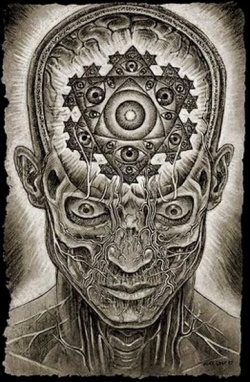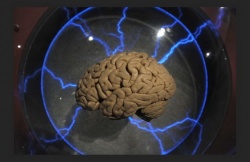Nine consciousnesses
- See also :
- See also :
NINE CONSCIOUSNESSES 九識 (Jpn ku-shiki )
Nine kinds of discernment. "Consciousness" is the translation of the Sanskrit Vijnana, which means discernment. The nine consciousnesses are
(1) sight-Consciousness (Skt chakshur-Vijnana ),
(2) hearing-Consciousness (shrota-Vijnana),
(3) smell-Consciousness (ghrana-Vijnana),
(4) taste-Consciousness (jihva-Vijnana),
(5) touch-Consciousness (kaya- Vijnana),
(6) Mind-Consciousness (mano-Vijnana),
(7) mano - Consciousness (mano-Vijnana),
(8) Alaya Consciousness (Alaya-vijnana), and
(9) amala -Consciousness (amala-Vijnana). (The Sanskrit is the same for both the sixth and seventh consciousnesses.)
The first five consciousnesses correspond to the five senses of sight, hearing, smell, taste, and touch. The sixth Consciousness integrates the perceptions of the five senses into coherent images and makes judgments about the external World. In contrast with the first six consciousnesses, which deal with the external World, the seventh, or mano -Consciousness, corresponds to the inner Spiritual World. Awareness of and Attachment to the self are said to originate from the mano-Consciousness, as does the ability to distinguish between Good and Evil. The eighth, or Alaya - Consciousness, exists in what modern psychology calls the Unconscious; all experiences of present and previous lifetimes—collectively called Karma—are stored there. The Alaya -Consciousness receives the results of one's Good and Evil deeds and stores them as karmic potentials or "seeds," which then produce the rewards of either Happiness or Suffering accordingly. Hence it was rendered as "storehouse Consciousness" in Chinese. The Alaya -Consciousness thus forms the framework of individual existence. the Dharma Characteristics (Chin Fa-hsiang; Jpn Hosso) school regards the eighth Consciousness as the source of all Spiritual and physical Phenomena. The Summary of the Mahayana (Shelun; Shoron) school, the T'ient'ai school, and the Flower Garland (Hua-yen; Kegon) school postulate a ninth Consciousness, called amala-Consciousness, which lies below the Alaya -Consciousness and remains free from all karmic impurity. This ninth Consciousness is defined as the basis of all Life's functions. Hence it was rendered as "fundamental pure Consciousness" in Chinese.
From the The Soka Gakkai Dictionary of Buddhism © 2002 Soka Gakkai International
==The nine consciousnesses==
Buddhism defines nine layers of Consciousness. This Doctrine helps to explain how Karma is stored and how it can be changed. The first five consciousnesses are the five senses of sight, hearing, touch, taste and smell. The sixth level is the Thinking Mind which integrates the Information we receive from these five senses. For instance, when you see a rose in blossom and smell its fragrance, your sixth sense integrates what you have seen and smelt to identify it as a rose.
The seventh Consciousness is where we Form judgements about what action to take. It corresponds to the Thinking and aware self which discerns value. “Shall I pick this rose?” you think. “No, better not, it”s in someone else”s garden.” This seventh level is the area of motivation and intention, much of it subconscious.
The eighth (Alaya Consciousness is the storehouse of our Karma. Alaya literally means “accumulation”, as in the name Himalaya mountains which means “accumulation of snow”. All of our experiences are filtered through the initial seven layers of Consciousness and stored in the eighth, which exists as an Unconscious memory of all our previous actions and reactions. This influences our reactions at any given time, based on our past experiences, including those of previous lifetimes.
You may recognize repetitive pattens in your behavior. You may find, for instance, that someone at work always makes you angry. Much as you reflect and determine that next time it happens you will rise above it, you find that you
are stuck in the same patten of behavior. Or you may find that after having had an unhappy relationship, you get together with a new partner, but that soon the same problems start to occur in the new relationship. These kinds of behavioral pattens are all included in Karma.
These patterns of behavior are also perpetuated in family groups. People whose Karma is similar are drawn together in families. For example, research has shown that children who are abused are, in turn, more likely to abuse their own children. On the face of it, one would think that a person who has suffered abuse is the least likely person to abuse others. The Doctrine of Karma clarifies why it is that people behave in these repeating cycles.
Psychology recognizes the existence of conditioned responses such as are stored in the eighth Consciousness and seeks to help people change these through understanding or self-awareness. Although it undoubtedly helps to understand our behavior with our rational minds, our most deeply ingrained Karma cannot be changed in this way, because the eighth Consciousness lies deeper than the rational Mind (seventh Consciousness). Our thoughts are therefore constantly influenced by our Karma.
In order to change Karma fundamentally, we have to get beyond its influence into the realm of the ninth Consciousness, which is pure and undefiled, free of karmic impurities. Nichiren Daishonin defined the ninth Consciousness as Nam-myoho-renge-kyo, the universal law of Life. When we chant Nam-myoho-renge-kyo, we are expressing our Buddhahood. As we do this more and more. we become aware of those karmic tendencies which are restricting us. As our confidence grows, we feel able to challenge these tendencies and establish a new direction in our lives, based on our ever-emerging Buddhahood.
The Buddha discovered a mystic law which simultaneously contains cause and effect, and designated it as myoho-renge. The single law of myoho- renge is perfectly endowed with all Phenomena in the Universe. Therefore, those who practice this law simultaneously acquire the cause and effect of Buddhahood.2
1 "Basics of Buddhism" by Pat Allwright Copyright © SGI-UK 1998 Published by Taplow Press
2 “Major Writings”, Vol. 7, pp. 65-6 (The translation here has been simplified for ease of understanding).
Source
- 1. sight consciousness (chakshur-vijnana )
- 2. hearing consciousness (shrota-vijnana)
- 3. smell consciousness (ghrana-vijnana)
- 4. taste consciousness (jihvavijnana)
- 5. touch consciousness (kaya-vijnana)
- 6. mind consciousness (mano-vijnana)
- 7. mano-consciousness; 'the inner spiritual world' (mano-vijnana)
- 8. alaya consciousness; 'store-house' consciousness; the 'unconscious' (alaya-vijnana)
- 9. amala consciousness; fundamental pure consciousness (amala-vijnana)

